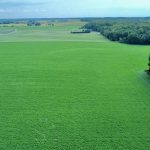Cattle producers need to take a closer look at the amount of vitamin E in their animal livestock feed, says a beef specialist.
New research shows most stored feed, such as hay, silage, greenfeed and swath grazing, doesn’t contain enough vitamin E to meet the animal’s nutritional requirements, said Barry Yaremcio, an Alberta Agriculture beef forage specialist.
“It’s coming to the forefront that vitamin E needs more attention.”
He said it’s now believed that the amount of vitamin E in rations should be increased to 100 international units per day from its traditional level of 60.
Read Also

Forecast leans toward cooling trend
July saw below average temperatures, August came in with near to slightly above average temperatures and September built on this warming trend with well above average temperatures for the month.
Vitamin E plays an important role in animals’ immunity, especially before calving, helps them make use of selenium, which prevents white muscle disease, and aids in reproduction and the control of nerves and muscles. Studies also show that a vitamin E deficiency in precalving rations results in more problems with mastitis and retained placentas.
Vitamin E is important in all ages of beef cattle.
It is a fat soluble vitamin in plants when they are actively growing. Once hay or silage is cut, the cell walls rupture, allowing oxygen into the cells, which breaks down vitamin E. By 60 to 90 days after the feed is cut, virtually no vitamin E is left in the feed. Fresh-growing forages have adequate amounts of vitamin E.
Yaremcio said most mineral rations contain vitamin E, but not enough to meet animals’ needs. It is one of the most expensive vitamins in the ration and the one easiest to reduce to help lower the cost of mineral supplements.
“It’s usually in the supplement, but not what it needs to be,” he said.
Bringing vitamin E requirements up to required levels will cost producers an additional two or three cents a day. Because the vitamin breaks down easily, producers should not put out more than four or five days worth of the mineral at a time. It becomes less effective if it becomes wet.
“As long as it stays dry, there should be no problem,” he said.
In Alberta, Cargill Foods, one of the largest packing plants, will not bid on cattle for slaughter unless the animals have been fed 50,000 IU of vitamin E before slaughter. The vitamin extends meat’s shelf life in the grocery store by two to three days and helps it keep a bright red colour.














